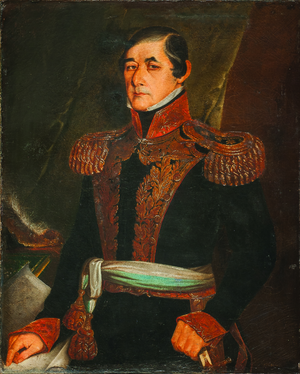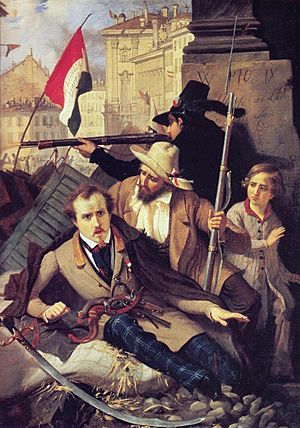Baldassare Verazzi facts for kids
Baldassare Verazzi (born January 6, 1819 – died January 18, 1886) was an important Italian painter. He is known for his historical and religious paintings. He also painted scenes from everyday life and portraits. Verazzi spent many years living and working in Argentina before returning to Italy.
Life of a Painter
Baldassare Verazzi was born in Caprezzo, a town in Piedmont, Italy. He started studying art at a young age. From 1833 to 1842, he attended the Academy of Brera in Milan. This was a famous art school. Later, in 1851, he also studied with Francesco Hayez. Hayez was a well-known Romantic painter from Venice. Verazzi often showed his paintings in art shows in cities like Turin and Milan.
His Art and Inspiration
Verazzi found ideas for his paintings in history and religion. For example, he painted a large picture about the life of Leonardo da Vinci. He also created religious works like The Holy Family in Egypt (1851). Another famous religious painting was The parable of the Samaritan. In 1854, he painted Raffaello Sanzio da Urbino presented by Bramante to Pope Julius II.
His most famous painting is Episode from the Five Days (Fighting at Palazzo Litta). This painting shows a dramatic moment from Italian history. You can see this masterpiece today at the Museum of the Risorgimento in Milan. The Risorgimento was the movement to unite Italy into one country.
Life in Argentina
Verazzi was very involved in the Risorgimento. Because of this, the Austrian authorities caused him trouble in 1848. He had to live under strict rules. In 1856, he decided to move to Argentina.
In Argentina, Verazzi continued his art career. He taught painting, and one of his students was the Argentine painter Cándido López. Verazzi painted many local people and scenes of daily life there. He also created historical paintings about important political and military events. He even helped decorate the first Teatro Colón, a famous opera house in Argentina.
Return to Italy
Later in his life, Verazzi returned to Italy. He settled near Lake Maggiore. The beautiful landscapes of this area gave him new ideas for his art. He often worked on these new paintings with his son, Serafino. Baldassare Verazzi passed away in Lesa when he was 67 years old.
Sources
- Biography of Baldassare Verazzi on the Magazzeno storico Verbanese site



